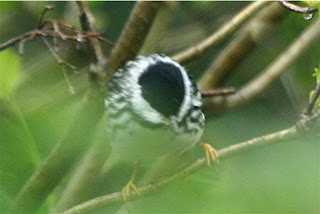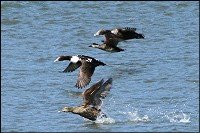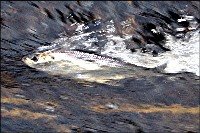.jpg) Our small narrow strip of deciduous trees, which we refer to as Bird Alley, was very busy this morning with many feeding birds, and so when I spied a black-capped, black and white bird in the tall branches of one of our Highbush Cranberries I automatically thought; Black-capped Chickadee. Then a second thought said; "take a closer
Our small narrow strip of deciduous trees, which we refer to as Bird Alley, was very busy this morning with many feeding birds, and so when I spied a black-capped, black and white bird in the tall branches of one of our Highbush Cranberries I automatically thought; Black-capped Chickadee. Then a second thought said; "take a closer .jpg) look" and I did and I realized it didn't have a black chin like a Black-capped Chickadee does and it had black and white streaking on its sides which a Chickadee doesn't have; and it had yellow feet! It was an adult breeding male Blackpoll Warbler, and from what I have since read, it is a common warbler often seen, though this was only my second sighting of one; previously having seen one in June, 2004. A welcome little feathered visitor to Bird Alley.
look" and I did and I realized it didn't have a black chin like a Black-capped Chickadee does and it had black and white streaking on its sides which a Chickadee doesn't have; and it had yellow feet! It was an adult breeding male Blackpoll Warbler, and from what I have since read, it is a common warbler often seen, though this was only my second sighting of one; previously having seen one in June, 2004. A welcome little feathered visitor to Bird Alley.


 now and then. This is character -istic of warblers for these tiny insect eating birds are often on the move. This male Yellow Warbler is easily identified by the red streaking on its yellow breast.
now and then. This is character -istic of warblers for these tiny insect eating birds are often on the move. This male Yellow Warbler is easily identified by the red streaking on its yellow breast.
.jpg)
.jpg)




.jpg)
.jpg)



.jpg)
.jpg)
.jpg)

.jpg)





.jpg)
.jpg)

.jpg)



.JPG)
.JPG)


.jpg)









.jpg)
.jpg)















